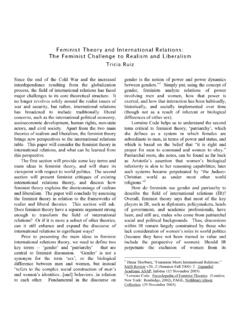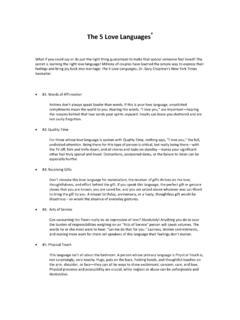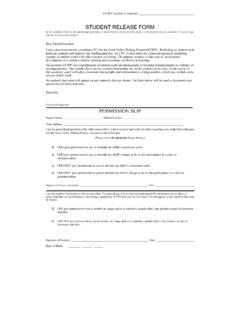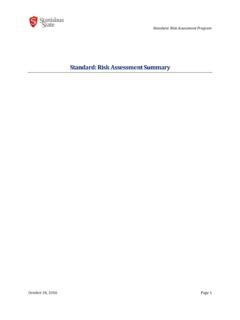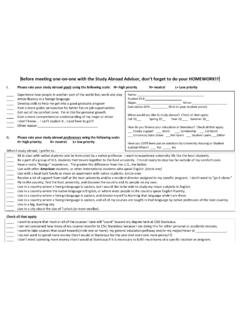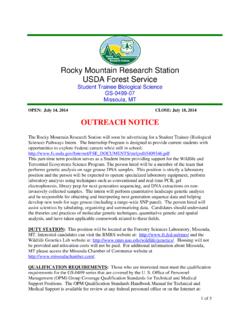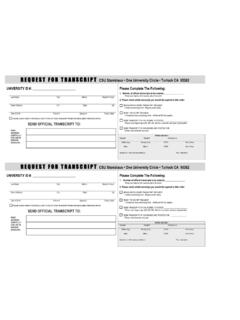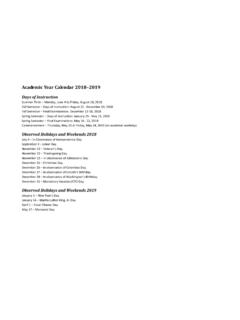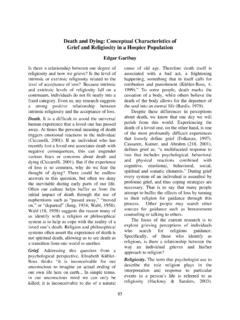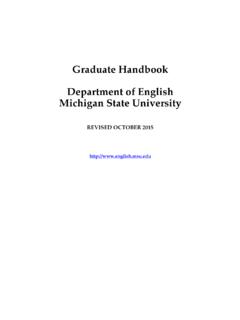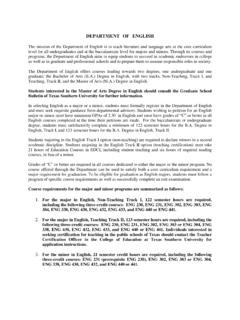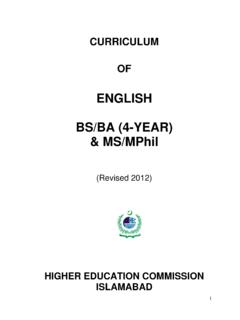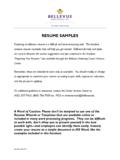Transcription of STRATEGIC PLAN 2007-2009 DEPARTMENT OF ENGLISH …
1 1 STRATEGIC PLAN 2007-2009 DEPARTMENT OF ENGLISH California State university , Stanislaus This STRATEGIC Plan represents an updating and revision of our STRATEGIC Plan of 2005-2007. The DEPARTMENT commits itself to using the STRATEGIC Planning process and to considering the plan itself as a living document, an on-going refinement of our goals and objectives. The goals that have been met, altered, or added since the last Plan are detailed in each section below. The STRATEGIC Plan has evolved into a regular biennial project, is used for programmatic and curricular decisions, and forms the basis for short and long term planning within the DEPARTMENT . It will be the benchmark and guideline for seven-year Academic Program Reviews. The following pages identify specific departmental objectives and ongoing STRATEGIC initiatives that are being pursued to realize CSU Stanislaus institutional and departmental goals.
2 Within seven broad objectives, several specific strategies are presented. These numbers do not represent a ranking of DEPARTMENT priorities. We conclude this plan with an Action Strategy for 2007-2009 that prioritizes specific objectives and assigns specific responsibilities. Mission of the university The faculty, staff, administrators, and students of California State university , Stanislaus are committed to creating a learning environment which encourages all members of the campus community to expand their intellectual, creative, and social horizons. We challenge one another to realize our potential, to appreciate and contribute to the enrichment of our diverse community, and to develop a passion for life-long learning. To facilitate this mission, we promote academic excellence in teaching and scholarly activities of our faculty, encourage personalized student learning, foster interactions and partnerships with our surrounding communities, and provide opportunities for the intellectual, cultural, and artistic enrichment of the region.
3 CSU Stanislaus Institutional Goals The key factor in the fulfillment of this multi-faceted university Mission is the dedication of the faculty to the teaching/learning process. As stated in our campus STRATEGIC Plan Pathways to the Future (1999), our university s learning-centered mission must be accomplished through the delivery of high quality academic programs taught by a faculty dedicated to student learning. CSU Stanislaus has won a reputation for providing a positive learning environment for a highly diverse student body. Student surveys cited in the 1998 Self-Study for WASC and the campus STRATEGIC Plan point out that Stanislaus faculty and staff have been rated by students as significantly more supportive than at comparable campuses across the nation, and students consistently praise our campus commitment to the quality of personal interaction among the faculty and students (Pathways to the Future, 1999, page 6).
4 The faculty of the ENGLISH DEPARTMENT recognizes these learning-centered qualities as fundamental to the achievement of our goals. Among the institutional goals expressed in Pathways, the goal that is central to the vision of the ENGLISH DEPARTMENT is the first achieving excellence in teaching and learning, and creating within the DEPARTMENT an environment that is conducive to that goal. The other nine goals are, to a great extent, consequences of that primary goal. This dedication to the continuous improvement of teaching and learning is reflected in recent campus discussions on the continuing vision and STRATEGIC objectives of the university . In the 2007 institutional STRATEGIC Plan, Framing the Future, California State university reaffirms and recommits itself to its core academic mission: the joy of teaching and learning. The ENGLISH DEPARTMENT recognizes its central mission as ensuring that Stanislaus graduates 1) demonstrate appropriate levels of proficiency in both oral and written expression, and 2) demonstrate a broad range of interpretive abilities and literary awareness.
5 These core skills are essential for the academic success and life-long learning of all students, but particularly for ENGLISH majors. Ensuring that all Stanislaus students learn how to write well is especially central to our mission when considering that, over the last decade, more than half of the DEPARTMENT courses provide direct support to academic programs across the university . Thus, promoting the development and assessment of students' academic writing skills has evolved into one of our major institutional responsibilities. 2 The following plan places emphasis on developing the personnel and other resources required to deliver high quality literature, language, and writing courses, and to assess, thoroughly and accurately, student learning outcomes--especially those that address writing skills--in those courses. DEPARTMENT Mission Statement The DEPARTMENT of ENGLISH supports the university s mission by providing opportunities for our students to develop literacy, critical thinking, and communication skills, as well as the knowledge of literature and aesthetic appreciation expected of culturally literate citizens and future teachers in our public schools.
6 The work of the ENGLISH DEPARTMENT is multi-faceted, offering instruction in literature and language courses for ENGLISH majors, single-subject (secondary education) students, general education, liberal studies, honors, and humanities. The DEPARTMENT also provides university -wide composition and writing programs, academic support (remedial) programs, concentrations for pre-credential students, a certification for Teaching of ENGLISH as a Second Language (TESOL), courses in service to international students, and graduate concentrations in Rhetoric and the Teaching of Writing, TESOL, and Literature that produce master teachers for our secondary schools and colleges. PROGRAM GOALS: Provide all Stanislaus students the opportunity to achieve appropriate levels of proficiency in written communication. Share with our students a rich variety of American, British, and World texts. Guide our students to develop a broad range of interpretive abilities and analytical skills.
7 Present the historical, cultural, and technical information necessary for students to become competent readers and scholars. Assist our students in the continual process of improving formal writing skills. Provide opportunities for students to practice their oral communication skills. Support our students as they prepare for and enter into professional life. Engage prospective teachers in the philosophy and practice of teaching language arts in secondary schools. STUDENT LEARNING GOALS / OBJECTIVES: Successful ENGLISH majors will: Master various analytical and critical reading skills, demonstrating the ability to read closely and to comprehend and interpret a variety of culturally diverse literary, non-literary, and visual texts. Gain broad knowledge of literature, achieving o Familiarity with the development and significant periods and movements of American, British, and World literatures.
8 O Knowledge of literary, critical, and theoretical terminology. o Understanding of background and contextual knowledge necessary for the well-informed consideration of various texts. Demonstrate formal writing skills by composing essays and other documents that o Make clear, organized, and well-reasoned arguments. o Analyze, develop, and synthesize concepts. o Reveal the ability to evaluate, incorporate, and document information. o Exhibit a sense of audience and occasion. o Display a mastery of grammar and language. Develop competent oral communication skills through class discussions and formal presentations. Gain understanding of intellectual and professional issues of the academy, including diversity, academic ethics, and canonicity. Successful MA students with a concentration in Literature will: Master the techniques and practices of literary analysis. Become familiar with the history and current theories of literary interpretation.
9 Acquire the abilities necessary to become professionals in the field of literature, whether as teachers or as other professionals. 3 Successful MA students with a concentration in Rhetoric & Teaching Writing will: Understand the historical development and major theories of rhetoric and composition. Master and apply the techniques and practices of rhetorical analysis. Acquire the abilities necessary to become professionals in the field of composition and rhetoric, whether as teachers or as other professionals. Successful MA students with a concentration in TESOL will: Gain knowledge and understanding of relevant concepts from the areas of linguistics, applied linguistics, sociolinguistics, psycholinguistics, and language teaching methodology. Acquire in-depth knowledge and understanding of the interaction between second language acquisition theory and second language teaching and learning.
10 Demonstrate expertise in curriculum design, assessment, teaching methods, and classroom management in various TESOL settings. In Fall 2004, programs offered or supported by the ENGLISH DEPARTMENT served hundreds of CSU Stanislaus students. The programs and services currently provided on campus by the ENGLISH DEPARTMENT are listed below with the number of students served by each in Fall 2002, Fall 2003, and Fall 2004, 2007 [these numbers will be updated]. Number Of Students Served in: Program: F07 F04 F03 F02 Majors in ENGLISH 233 232 207 Minors in ENGLISH 23 28 23 Single Subject Preparation Program (Data not available through IR) 92 325 TESOL Undergraduate Concentration 36 28 26 TESOL certificates: Data not available through IR Liberal Studies (F02 non-segregated) LIBS majors, Concentration in ENGL 74 56 61 LIBS majors, Concentration in TESOL 15 12 6 LIBS majors, Concentration in HUM 0 0 0 MA Students (Literature, RTW, and TESOL) 36 27 28 Post baccalaureate Students 9 16 18 Credential Students 2 2 0 General Education (1001, 1002, 1010, 3550, 3920, 3940) 673 622 667 First-Year Composition 373 368 366 Intensive Learning Experience (ILE) 160 170 146 Writers Workshop 167 130 130 ESL Courses 69 23 23 Writing Center (ILE: 164; WW: 165; ESL: 29.)
